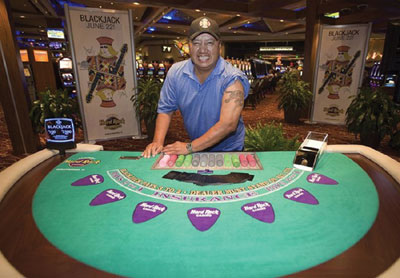By Rafael Olmeda and Andrew Boryga
 Max Osceola Jr., a longtime leader for the Seminole Tribe of Florida as it grew larger and more successful with its high-profile Hard Rock casinos and other attractions, died Thursday evening from complications due to COVID-19.
Max Osceola Jr., a longtime leader for the Seminole Tribe of Florida as it grew larger and more successful with its high-profile Hard Rock casinos and other attractions, died Thursday evening from complications due to COVID-19.
Osceola, a former member of the Tribal Council, was at the Cleveland Clinic in Weston, undergoing treatment for the last weeks of his life. He was 70.
Advertisement
He was an elected Seminole Tribal Council representative from the Hollywood Seminole Reservation from 1985 through 2010, according to a Tribe spokesman. During his tenure, the tribe expanded its gambling operations and oversaw the construction of many destinations, including the Seminole Hard Rock Hotel and Casino, one of the largest tourist attractions in Broward County.
“He was absolutely focused on overseeing the development of the Seminole casinos,” said Tribe spokesman Gary Bitner.
Phil Hogen, the former chairman of the National Indian Gaming Commission, said he worked closely with Osceola during the Seminole Tribe’s impressive rise in stature.
“At light speed, they made the transition from doing alligator shows out of a shoe box to suddenly having mega-million bingo operations and before you knew it Class III casinos.” Hogen said the rise was “not smooth all of the time.”
Hogen said the Seminole Tribe was one of the first to get into the casino and gambling business and had their own way of doing things before the national gaming commission was established in 1988.
He said Osceola was instrumental in helping the tribe adapt to new regulatory restrictions and oversight.
“Max was always hands-on and right there in the middle of that stuff,” he said. “He was a big help in making the transition from a very traditional tribal culture arrangement to the 21st Century.”
In addition to his stewardship of the Seminole tribe and their properties, Osceola was also known for his lively personality.
“He was perhaps best known for his smile, infectious laugh and constant barrage of quips and one-liners, often referring to ‘B.C.’ as the time ‘before casinos’ at the Seminole Tribe,” Bitner said.
Max Osceola, a longtime Seminole tribe leader, stands behind a blackjack table on June 6, 2008. (Michael Laughlin / Sun Sentinel)
The tribe considered Osceola an “ambassador to the South Florida community,” applauding his support of the region’s tourism industry and other community activities, including the Boys and Girls Clubs, Ann Storck Center and Winterfest.
His wife, Marge, said Max’s Seminole name translates to “storyteller,” a name he lived up to throughout his life.
“Our ancestors sold Manhattan for trinkets,” Osceola said at the 2006 news conference announcing the Seminole Tribe’s purchase of Hard Rock International. “Today, with the acquisition of the Hard Rock Cafes, we’re going to buy it back one hamburger at a time.”
In 2005, when he was the council’s vice chairman, Osceola supported a resolution approving the use of the Seminole name and associated logos by the Florida State Seminoles college football team.
Osceola’s tenure was not without controversy, however. A 2007 South Florida Sun Sentinel investigation described Osceola as one of the tribe’s longest-serving and most powerful politicians. The newspaper documented the tribe’s increase in wealth, lavish spending by council members and the steering of millions of dollars and business to their families and friends.
According to the report, Osceola was paid more than $300,000 a year and collected about $120,000 more from the tribe’s gambling profits. The IRS had outstanding liens against Osceola totaling almost $1 million for unpaid income taxes dating to 1993, records showed. He explained that he was paying off the debt.
According to a statement from the tribe announcing his passing, Osceola was born in August 1950 in Hollywood and grew up on the Hollywood Seminole Reservation. He graduated from McArthur High School in Hollywood and attended the University of Tampa, where he played college football. He graduated from the University of Miami and was a fervent supporter of Miami Hurricanes Football.
He was inducted in the Broward Education Foundation Hall of Fame in 2017. In 2003, he also was inducted into the Broward County Sports Hall of Fame.
Pat McQuaid, the former longtime coach of the Nova High School baseball team, said he grew up with Osceola in Hollywood.
He recalled fond memories of the two of them playing little league sports together and his visits to the Seminole reservation.
McQuaid said the tribe was not nearly as financially successful at the time, but he remembered that Osceola was always very proud of his tribe and their culture. As he got older, he said Osceola made it a point to wear his traditional native dress when he was in public.
Despite Osceola’s success, McQuaid said he remained grounded in his later years. “He was a humble man,” McQuaid said. “A good friend who will be missed.”
Seminole Tribal Council Rep. Chris Osceola (no relation), agreed. “He will forever be embedded in our hearts and the history of the Seminole Tribe,” he said. “He was my friend and mentor and I will miss him dearly.”
In addition to his wife, Osceola is survived by his son Max Osceola III, daughter Melissa Osceola DeMayo, daughter Meaghan Osceola, son Jeff Pelage, as well as several sisters and brothers, grandchildren and extended family.
Funeral services will be private. A celebration of life will take place at some future time.

